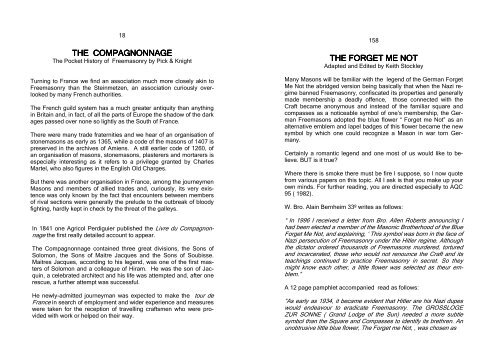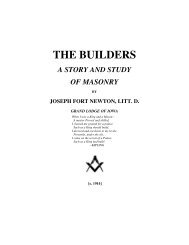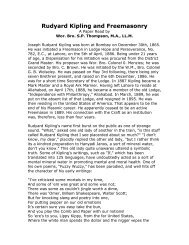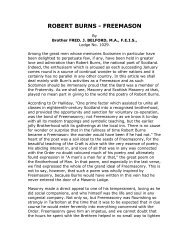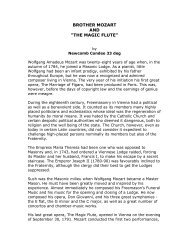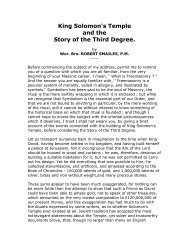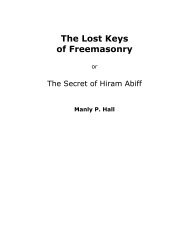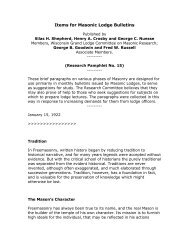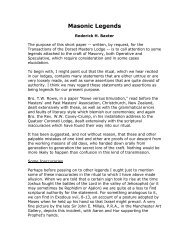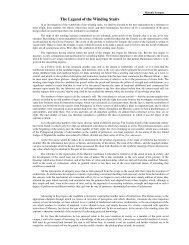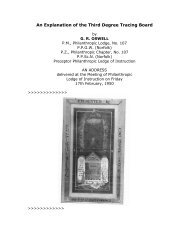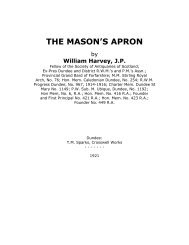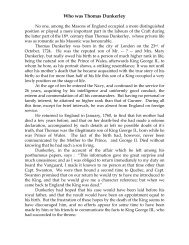Through the Key Hole - RoseCroix.org.au
Through the Key Hole - RoseCroix.org.au
Through the Key Hole - RoseCroix.org.au
Create successful ePaper yourself
Turn your PDF publications into a flip-book with our unique Google optimized e-Paper software.
18<br />
THE COMPAGNONNAGE<br />
The Pocket History of Freemasonry by Pick & Knight<br />
Turning to France we find an association much more closely akin to<br />
Freemasonry than <strong>the</strong> Steinmetzen, an association curiously overlooked<br />
by many French <strong>au</strong>thorities.<br />
The French guild system has a much greater antiquity than anything<br />
in Britain and, in fact, of all <strong>the</strong> parts of Europe <strong>the</strong> shadow of <strong>the</strong> dark<br />
ages passed over none so lightly as <strong>the</strong> South of France.<br />
There were many trade fraternities and we hear of an <strong>org</strong>anisation of<br />
stonemasons as early as 1365, while a code of <strong>the</strong> masons of 1407 is<br />
preserved in <strong>the</strong> archives of Amiens. A still earlier code of 1260, of<br />
an <strong>org</strong>anisation of masons, stonemasons, plasterers and mortarers is<br />
especially interesting as it refers to a privilege granted by Charles<br />
Martel, who also figures in <strong>the</strong> English Old Charges.<br />
But <strong>the</strong>re was ano<strong>the</strong>r <strong>org</strong>anisation in France, among <strong>the</strong> journeymen<br />
Masons and members of allied trades and, curiously, its very existence<br />
was only known by <strong>the</strong> fact that encounters between members<br />
of rival sections were generally <strong>the</strong> prelude to <strong>the</strong> outbreak of bloody<br />
fighting, hardly kept in check by <strong>the</strong> threat of <strong>the</strong> galleys.<br />
In 1841 one Agricol Perdiguier published <strong>the</strong> Livre du Compagnonnage<br />
<strong>the</strong> first really detailed account to appear.<br />
The Compagnonnage contained three great divisions, <strong>the</strong> Sons of<br />
Solomon, <strong>the</strong> Sons of Maitre Jacques and <strong>the</strong> Sons of Soubisse.<br />
Maitres Jacques, according to his legend, was one of <strong>the</strong> first masters<br />
of Solomon and a colleague of Hiram. He was <strong>the</strong> son of Jacquin,<br />
a celebrated architect and his life was attempted and, after one<br />
rescue, a fur<strong>the</strong>r attempt was successful.<br />
He newly-admitted journeyman was expected to make <strong>the</strong> tour de<br />
France in search of employment and wider experience and measures<br />
were taken for <strong>the</strong> reception of travelling craftsmen who were provided<br />
with work or helped on <strong>the</strong>ir way.<br />
158<br />
THE FORGET ME NOT<br />
Adapted and Edited by Keith Stockley<br />
Many Masons will be familiar with <strong>the</strong> legend of <strong>the</strong> German F<strong>org</strong>et<br />
Me Not <strong>the</strong> abridged version being basically that when <strong>the</strong> Nazi regime<br />
banned Freemasonry, confiscated its properties and generally<br />
made membership a deadly offence, those connected with <strong>the</strong><br />
Craft became anonymous and instead of <strong>the</strong> familiar square and<br />
compasses as a noticeable symbol of one’s membership, <strong>the</strong> German<br />
Freemasons adopted <strong>the</strong> blue flower “ F<strong>org</strong>et me Not” as an<br />
alternative emblem and lapel badges of this flower became <strong>the</strong> new<br />
symbol by which one could recognize a Mason in war torn Germany.<br />
Certainly a romantic legend and one most of us would like to believe.<br />
BUT is it true?<br />
Where <strong>the</strong>re is smoke <strong>the</strong>re must be fire I suppose, so I now quote<br />
from various papers on this topic. All I ask is that you make up your<br />
own minds. For fur<strong>the</strong>r reading, you are directed especially to AQC<br />
95 ( 1982).<br />
W. Bro. Alain Bernheim 33º writes as follows:<br />
“ In 1996 I received a letter from Bro. Allen Roberts announcing I<br />
had been elected a member of <strong>the</strong> Masonic Bro<strong>the</strong>rhood of <strong>the</strong> Blue<br />
F<strong>org</strong>et Me Not, and explaining, ‘ This symbol was born in <strong>the</strong> face of<br />
Nazi persecution of Freemasonry under <strong>the</strong> Hitler regime. Although<br />
<strong>the</strong> dictator ordered thousands of Freemasons murdered, tortured<br />
and incarcerated, those who would not renounce <strong>the</strong> Craft and its<br />
teachings continued to practice Freemasonry in secret. So <strong>the</strong>y<br />
might know each o<strong>the</strong>r, a little flower was selected as <strong>the</strong>ur emblem.”<br />
A 12 page pamphlet accompanied read as follows:<br />
“As early as 1934, it became evident that Hitler are his Nazi dupes<br />
would endeavour to eradicate Freemasonry. The GROSSLOGE<br />
ZUR SONNE ( Grand Lodge of <strong>the</strong> Sun) needed a more subtle<br />
symbol than <strong>the</strong> Square and Compasses to identify its brethren. An<br />
unobtrusive little blue flower, The F<strong>org</strong>et me Not, , was chosen as


